Betta fish (Betta splendens) are one of the most popular fish species available today and male Bettas are widely appreciated for their wide range of beautiful colors and many fin types. Female Bettas, however, are a lot more difficult to find in the hobby and overlooked by most aquarists. They are often thought of as ‘dull’ compared to their male counterparts – even though their colors can be just as lovely and there are actually a few advantages to keeping females.
Keep reading for everything you need to know about identifying female Bettas and why you might want to consider them over males!
Note: There is a lot of inaccurate info on Betta keeping out there. Bettas should always be kept in an aquarium of at least five gallons. If you’re interested in keeping Bettas, be sure to have a look at the full Betta caresheet.

How to sex a Betta
Figuring out whether a Betta is male or female can sometimes be a little difficult, especially because they’re often unlabeled or mislabeled in pet- and aquarium stores. Female Bettas are short-finned so if a Betta has very long finnage it’s almost certainly male (with some exceptions), but what about short-finned (plakat) males? Here’s what you should be looking at if a short-finned Betta is causing some confusion:
- Ventral fins: The ventral fins are located on the underside of the fish just below the head. Male Bettas will often sport long ventral fins. In females, just like the rest of their finnage, the ventrals will usually be a lot shorter.
- Anal fin: Female Bettas will often have a rounded anal fin, while most males have a pointed anal fin.
- Body shape: A female carrying eggs is quite easy to recognize: her belly will look round and swollen. Even when not eggy, females will still be slightly rounder (and smaller) than males.
- Ovipositor: Also called an egg spot, female Bettas have an ovipositor which looks like a tiny white speck or grain of salt right behind their ventral fins. Just don’t confuse a protruding vent with an ovipositor – always double check using the other items on this list, as males can sometimes appear to have an ovipositor even though they don’t.
- Beard: Both male and female Bettas have a beard, which becomes visible when they flare their gills. However, the beard will be much larger in males than in females.
- Bubble nesting, aggression, color: While these can differ, they won’t always. Most female Bettas don’t build bubble nests, but some will. Most female Bettas will be less aggressive than males, but some definitely aren’t. Some female Bettas will have less bright coloration than males but many will be just as colorful!
Keep in mind that female Bettas can be very similar to males: don’t just rely on one item on this list, be sure to check all of them. Sexing young Bettas can be especially difficult, so you might want to double-check once the fish has matured.
Why keep female bettas?
For hobbyist fishkeepers, keeping female bettas is often not the first thing that comes to mind. Males are thought of as more attractive with their often extravagant finnage, whereas females are seen as boring or bland. In reality they are just as active and fun to watch as their male counterparts. They will still flare, explore their aquarium and eventually recognize their owner.
Due to their shorter finnage, females won’t suffer from the ‘handicaps’ that male long-finned Bettas, especially the more extreme rosetails/feathertails and halfmoons, often struggle with. Very long finnage can lead to problems such as collapsed fin rays and inability to swim properly with tail biting as a result.
Female Bettas will often sit in aquarium stores much longer than males. So if you’re looking to take a new Betta home, consider giving a female a chance!
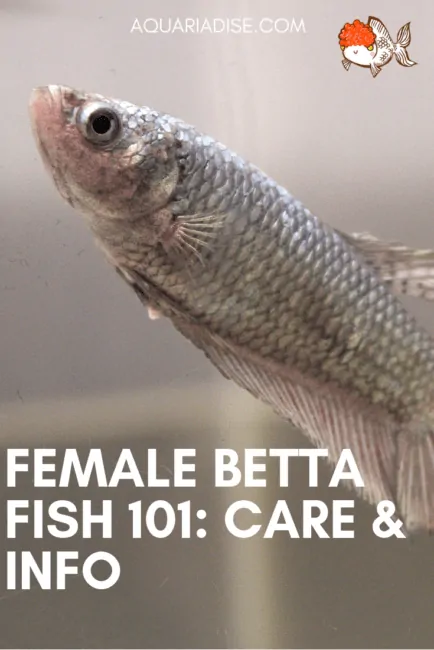
If you have any more questions about keeping female Bettas or sexing Bettas or if you just want to share your own experiences with female Bettas, don’t hesitate to leave a comment below. Happy fishkeeping!
Cover photo: Betta female 1 by bored-now

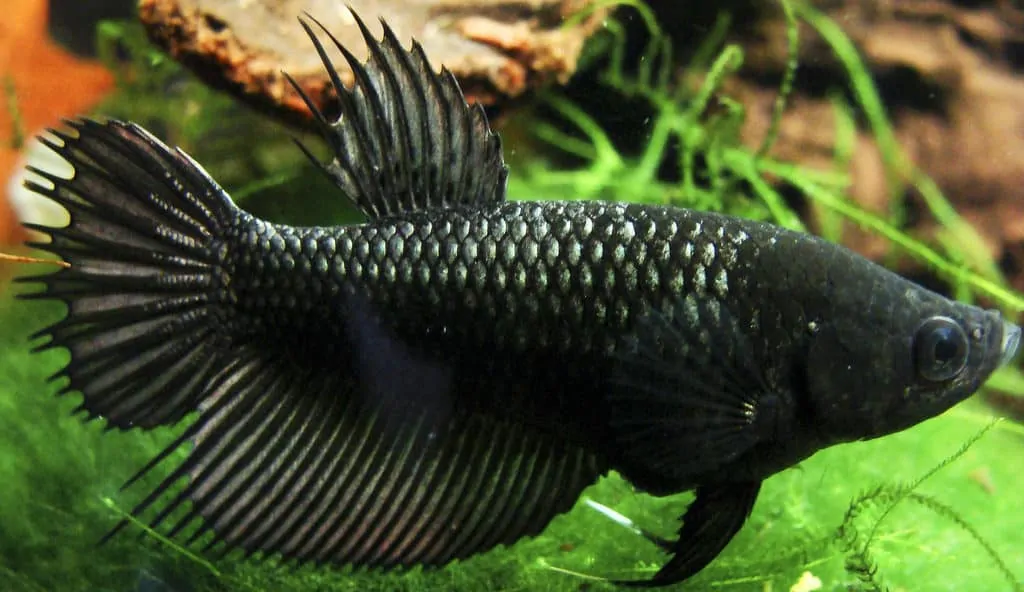
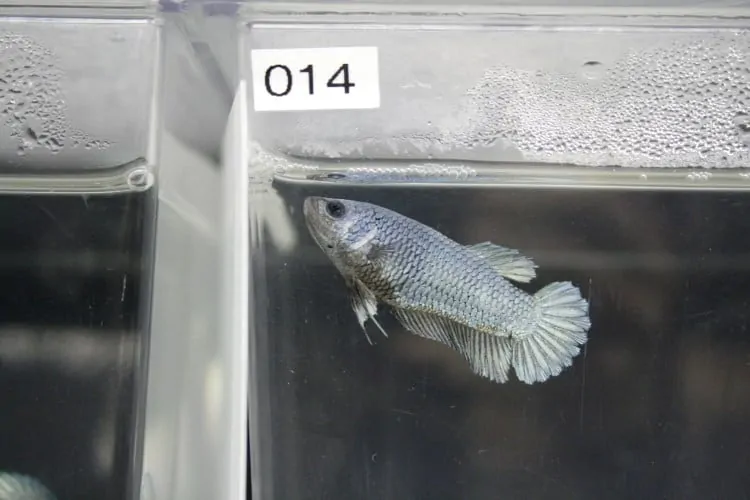
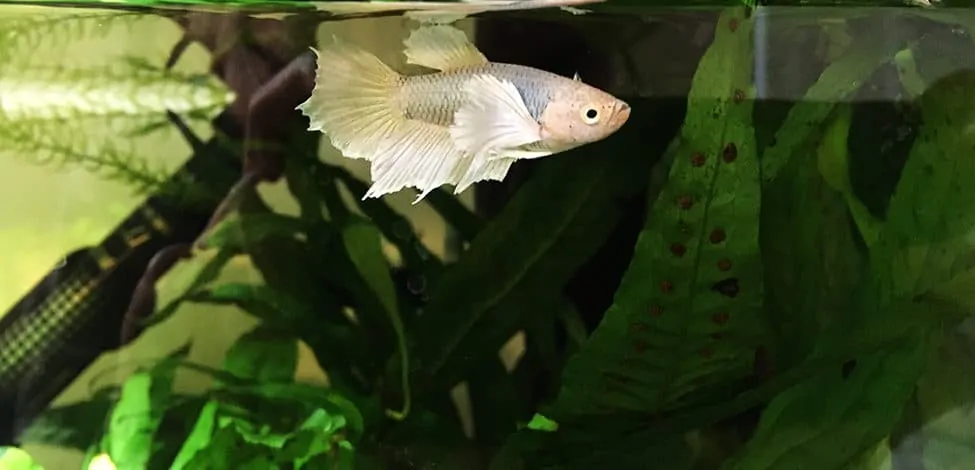
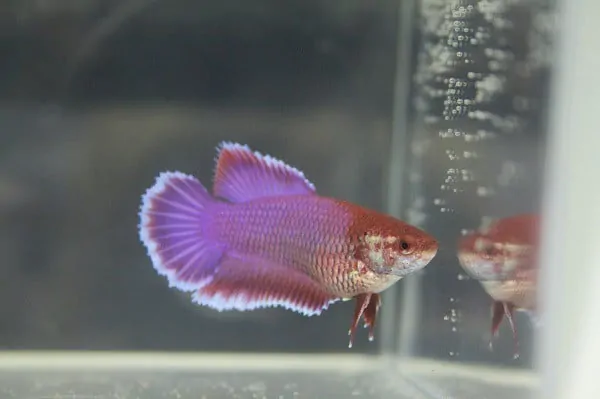
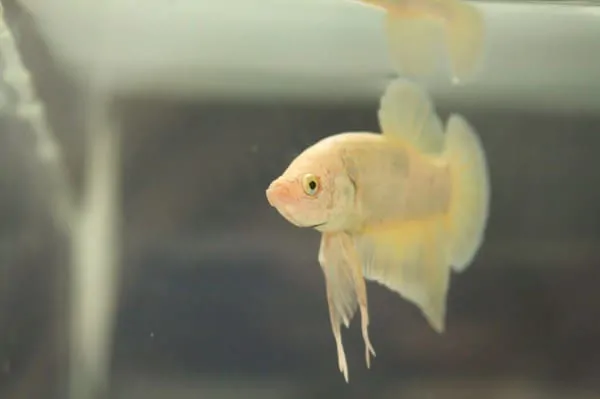
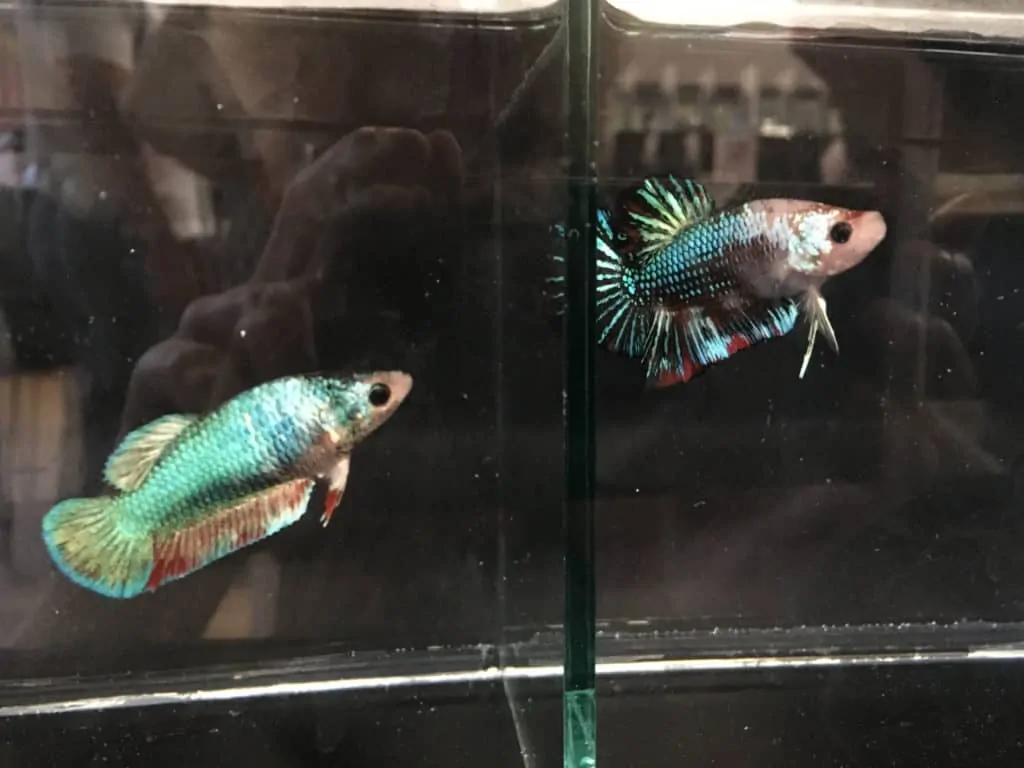

I recently set up a ten gallon tank with lots of plants in it! I wasn’t going to put anything in the tank and just let the plants grow out, and let the roots sink in, but when I went to petsmart the other day to look at their sand selection, I couldn’t help but go over to the betta’s (also cause they had a really pretty black and blue iridescent one the last time I was there, so I wanted to see if he was still there as well!) and saw a lone halfmoon male. He was pretty, a silvery white with a scarlet crown on his head, but next to him was this creamy biege female halfmoon. I looked at her and thought she was just as pretty, but noticed how sad she looked. The more I looked at her, the more I thought “I can’t leave her here.”
So I brought her home and put her in my ten gallon, and gosh–this is the second time I’ve seen a fish that was so happy in my life! She couldn’t stop exploring; she lays on the dwarf grass, sleeps under the anubis nana and likes to hide behind the only fake item in my tank: a minature trex skull. I’ve had her for three days now, and she’s doing absolutely amazing and I do like her very much! She has her weird little quirks and is kind of an oddball, but she’s so much happier. Her fins were clamped tight when I first saw her, and I haven’t seen them like that since. Always flared up and swimming about!
Thanks for sharing, that’s so lovely! Nice to see another happy female betta owner.
That’s really cool u saved her like that! I can hardly stand to go to the pet stores after a worker their one day told me some things about what these poor Bettas have to go thru to get to the store.,!! It’s sad! I had went to the pet store one day.. about 6-7 months ago.. an had the idea to get a Betta an put it in a big glass pitcher type with bamboo in it… Well … That little plan quickly flew out the window! An today.. I have 4 – 10 gallon tanks –
1 – 5 gallon tank- 1- 3.5 gal tank & 1- 30 gallon tank !!! An 9 Bettas !! An I can tell u… That stemmed from just being addicted to saving them from the store!!! I didn’t have any clue at all what I was about to get myself into when I got the little Betta in a bowl plan!!
I’m amazed at how little I knew about these fascinating yet time consuming fish in comparison to what all I’ve learned .. to still have do much to learn! Practically gotta be a chemist or biologist ! Ha
Anyways . Didn’t mean to write a book! It’s just that ur Betta story was a really cool deal ! An always appreciate it when these Bettas are rescued an put into a happy environment!! An I understand how tuff it mighra been for u to choose the female over the male! Cuz if the big difference in their looks!!
Thanks for sharing your story!
Bettas are as awesome as the owner who provides a happy place for them!!
Is it possible to keep more than one female beta in the same Thank? Or should they be kept separate like the males? Thank you.
Some aquarists do it and will tell you its okay, but with the amount of incidents and fighting I’ve seen it’s a firm no from me. Keep them separate! Much safer.
Hi Deedee,
I currently own several bettas–one adult male, one adult female, and three juvenile females. Every single one of them has their own home, and they are the sole inhabitants of their respective homes. They purposely can’t even see each other! If you get anything else from my story, it’s this: keep them separate! Not trying to beat a dead horse; just had a recent experience…
The three juveniles I had bought in hopes of setting up a “sorority tank”, where multiple females live together in general harmony. Bettas aren’t schooling fish, but the females can sometimes be kept together successfully in such an arrangement. You need at least 3, and a large tank, maybe 40 gallons minimum? I wish I had known that last part. When I put the three of them into the tank I had, they would constantly bicker. I thought it would subside after a few minutes, but after 20 minutes they were still sneaking up on each other and attacking one another. There was no major fighting per se, but the constant bickering was stressful for me to watch, let alone the stress they would all be feeling! While it has been done successfully by others, my experience tells me that maintaining multiple betta tanks is less stressful than maintaining one with constant conflict between fish.
Now all of them are separated, in temporary housing (no, not bowls) until their proper aquaria finish cycling. They’re all quite happy and active, not hiding! It’s nice to see, even if it takes a little more time to maintain!
Thanks for sharing! I agree sororities are a very risky thing and it’s just not ideal. Even if they seem succesful, something can suddenly shift and the females can end up killing each other. That’s why I didn’t mention sororities in this post – I just wouldn’t recommend taking that risk. Good job on separating them and best of luck 🙂
I live for the females, they’re beautiful as the males just in different ways. I keep females only, and as a result of the shorter less delicate fins (along with pristine water quality) I have never had one occurrence of the most common betta illness: fin rot. Not a single blowout or fin tear on decor, no fin biting or exhaustion from swimming with heavy fins! Orchid (my teal and fusha female VT) swims fast and strong, and can hold her own swimming thru her filters output. I know all bettas have their own personality but (perhaps bc of lower aggression) the females have always seemed more affectionate too, both my female CT and VT jumped for their food and would curl around my finger or swim in my palm when hands would be in tank. Bottom line: If you get a lady betta I promise you will be a very proud fish parent!
Thanks for sharing! I agree with the fin rot part, short finned Bettas (like females) seem so much more comfortable without the long, heavy finnage.
I got a female betta for my 5 gallon and it is the best decision ever! She was pretty young when I got her and really pale—like see-through. Her fins have gotten pinker and now her scales have a pearlescent look which is really cool. I really encourage every one to get a female betta. Thank you for all the great articles, keep it up!
Thanks for sharing! Sounds like a very pretty fish. 🙂